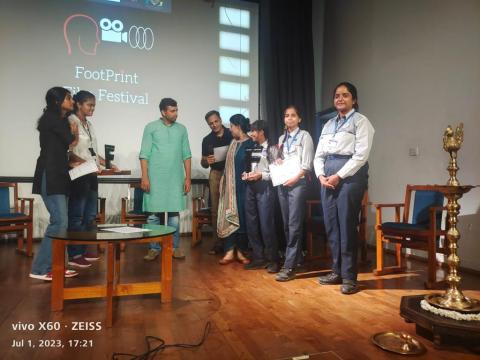
Lights, Camera, Education: Integrating Movie-Making for Inspired Learning
In this rapidly evolving digital age, it has become increasingly evident that video is the chief language of modern times. GN Devi, a renowned scholar, eloquently stated this fact in one of his enlightening talks. All around us, we witness people engrossed in videos, spending a significant portion of their time indulging in this captivating medium. The entertainment industry, corporate sector, and even politics have recognized the immense value of video and have invested substantial resources into harnessing its power. However, when it comes to education, we find a hesitant and sporadic embrace of this new medium.
Whether we embrace it or not, video is poised to become the most dominant form of human communication. As Rahul Sankrityan wisely wrote in his classic book, "Volga se Ganga Tak," a generation equipped with copper tools would never willingly revert to stone tools. Likewise, expressing ourselves through video necessitates an entirely different set of skills. It is not merely a singular skill, but rather the accumulation of various abilities. Writing, drafting, scripting, storytelling, and the technical aspects of recording, sound, and lighting all contribute to the art of video creation. Proficiency in graphics and video editing tools, such as Photoshop, have become vital in enabling the younger generation to communicate effectively through this new language—let us refer to it as "movie-making."
It has been over a century since one of the most profound educational thinkers, John Dewey, began writing and experimenting with the power of meaningful projects in children's lives. Movie-making is precisely such a meaningful project. By assigning students the task of creating short films, they embark on a journey that culminates in a product with inherent meaning. This process requires the utilization of diverse skills, brought together to produce a compelling piece of cinema. Furthermore, movie-making fosters collaboration—an indispensable skill in human civilization. The ability to work together, to harness the collective wisdom and creativity of a team, is paramount, and movie-making inherently promotes this essential aspect.
I was fortunate to witness the wonders that children produced at the Footprint Film Festival held at the Indira Gandhi National Centre for the Arts. Young talents from all corners of the country participated, creating and submitting their captivating short films for screening. The event also featured an "Instant Film Making" segment, where students from Delhi Government schools showcased their remarkable creations. Witnessing the cityscape of their ideas materialize on screen was truly awe-inspiring.
One of the most remarkable features of the festival was the "Film Adda." Following the screenings, children gathered to engage in thoughtful discussions about their conceptualization process, the challenges they encountered, and the messages they aimed to convey to the audience. These conversations were profoundly engaging and thought-provoking. Reflecting on this experience, it became apparent to me that movie-making must emerge as one of the most dominant pedagogical models of education. It should no longer be confined to computer or ICT-related projects but should permeate every discipline. Whether a teacher is instructing language, social sciences, mathematics, or science, they can all assign students to create short films on given topics. Naturally, this would require teachers to develop new skills, but the urgency of this shift cannot be overstated. Let us remember GN Devi's words—video is the new language. Sooner or later, this medium of communication will dominate our teaching and learning, whether it is mathematics or Hindi. Embracing video as an educational tool holds immense potential. It enables students to engage with their subjects in a dynamic and creative manner. By immersing themselves in movie-making, they develop critical thinking, problem-solving, communication, and collaboration skills—all vital for success in the 21st century. Moreover, creating videos
encourages students to think deeply about the content they are studying. It prompts them to explore different perspectives, conduct research, and present their findings in a visually compelling and persuasive manner. Through the process of movie-making, students become active participants in their own education, taking ownership of their learning and developing a sense of pride and accomplishment. video has a unique ability to capture emotions, tell stories, and evoke empathy. It engages multiple senses, making the learning experience more immersive and memorable. By incorporating video into various subjects, teachers can tap into students' natural curiosity and creativity, fostering a love for learning that extends beyond the confines of the classroom.
Of course, implementing movie-making as a pedagogical model requires investment and training. Educators need access to resources, equipment, and software that facilitate video production. Professional development programs should be offered to teachers, equipping them with the necessary technical skills and strategies to integrate video into their lessons effectively. Collaborations with professionals from the film industry can also provide invaluable mentorship opportunities for both teachers and students.
In conclusion, video has emerged as the chief language of our modern times. Its power and influence are undeniable, permeating various aspects of society. As the education system continues to evolve, it is essential to recognize the potential of video as a transformative tool for teaching and learning. By embracing movie-making as a pedagogical model, we empower students to develop critical skills, engage with their subjects in a meaningful way, and prepare them for the demands of the digital age. Let us not delay this necessary shift any longer. The future of education lies in the hands of those who dare to unlock the power of video.
Imagine a classroom where students are not just passive recipients of information but active creators of knowledge. Picture the excitement and engagement as they collaborate, brainstorm ideas, write scripts, shoot scenes, and edit their own short films. This is the future we can create through the integration of movie-making into education.
- Log in to post comments
